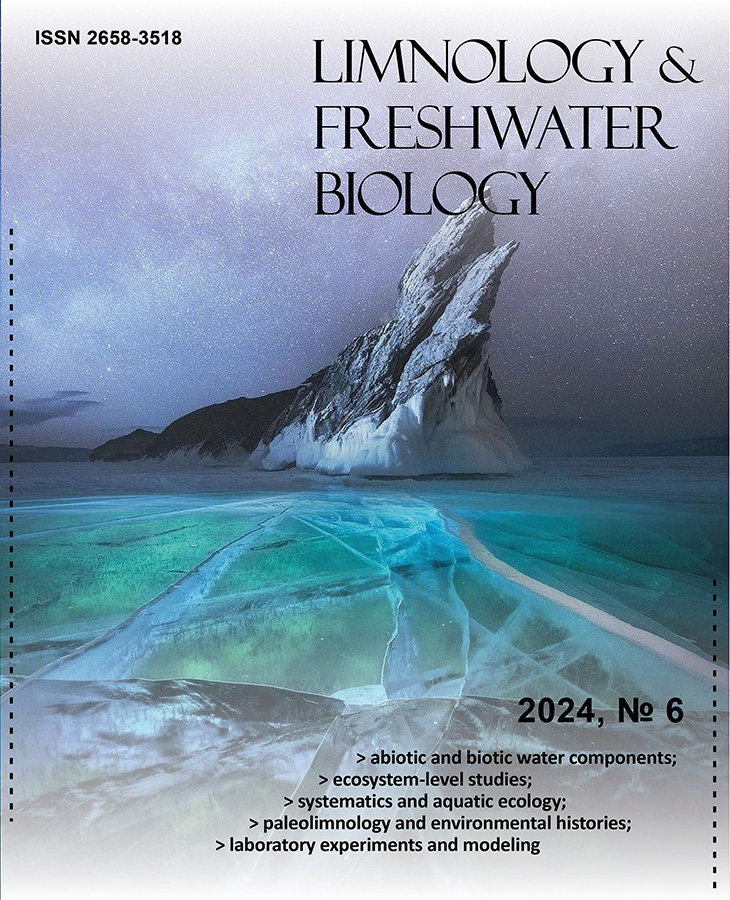The phylogeny based on the intron of ATP synthase α-subunit gene reveals a substrate role in the origin of the gastropod species flock from Lake Baikal
- Authors: Kovalenkova M.V.1, Bukin Y.S.1,2, Sitnikova T.Y.1, Sherbakov D.Y.1,2
-
Affiliations:
- Limnological Institute of the Siberian Branch of the Russian Academy of Sciences
- Irkutsk State University
- Issue: No 2 (2020)
- Pages: 405-411
- Section: Articles
- URL: https://journal-vniispk.ru/2658-3518/article/view/283760
- DOI: https://doi.org/10.31951/2658-3518-2020-A-2-405
- ID: 283760
Cite item
Full Text
Abstract
A nuclear marker, an intron of ATP synthase α-subunit gene, used to determine phylogenetic relationships between 22 species of the family Baicaliidae (Caenogastropoda: Rissooidea) indicated two genetic groups of these gastropods in Lake Baikal. The obtained groups partially coincide with the clusters revealed by the mitochondrial COI gene and do not fully coincide with the modern taxonomy of the family. Thirteen species of the first group inhabit different sediments (silty sand, sand, stones, and rocks), eight out of the nine species from the second group are psammobionts. Both genetic groups include eurybathic and stenobathic species widely distributed in the North, Middle and Southern Basins of the lake, as well as species, whose habitats are limited to one or two basins. Phylogenetic analysis suggests that the main way of baicaliids speciation was the repeated occupation of the same habitats by different ancestral forms. Sculpture of the shells (ribs, carina and/or periostracal hairs/plates) also most likely appeared independently in each group due to similar adaptation.
Keywords
About the authors
M. V. Kovalenkova
Limnological Institute of the Siberian Branch of the Russian Academy of Sciences
Author for correspondence.
Email: mkovalenkova@gmail.com
Russian Federation, 3, Ulan-Batorskaya St., Irkutsk, 664033
Yu. S. Bukin
Limnological Institute of the Siberian Branch of the Russian Academy of Sciences; Irkutsk State University
Email: mkovalenkova@gmail.com
Russian Federation, 3, Ulan-Batorskaya St., Irkutsk, 664033; 1, Karl Marx St., Irkutsk, 664003
T. Ya. Sitnikova
Limnological Institute of the Siberian Branch of the Russian Academy of Sciences
Email: mkovalenkova@gmail.com
Russian Federation, 3, Ulan-Batorskaya St., Irkutsk, 664033
D. Yu. Sherbakov
Limnological Institute of the Siberian Branch of the Russian Academy of Sciences; Irkutsk State University
Email: mkovalenkova@gmail.com
Russian Federation, 3, Ulan-Batorskaya St., Irkutsk, 664033; 1, Karl Marx St., Irkutsk, 664003
References
- Ackerly D.D., Schwilk D.W., Webb C.O. 2006. Niche evolution and adaptive radiation: testing the order of trait divergence. Ecology 87: 50-61. doi: 10.1890/0012-9658(2006)87[50:NEAART]2.0.CO;2
- Benjamini Y., Hochberg Y. 1995. Controlling the false discovery rate: a practical and powerful approach to multiple testing. Journal of the Royal Statistical Society: Series B (Methodological) 57: 289-300. doi: 10.1111/j.2517-6161.1995.tb02031.x
- Brooks J.L. 1950. Speciation in ancient lakes. The Quarterly Review of Biology 25: 131-176. doi: 10.1086/397539
- Chong J.P., Harris J.L., Roe K.J. 2016. Incongruence between mt DNA and nuclear data in the freshwater mussel genus Cyprogenia (Bivalvia: Unionidae) and its impact on species delineation. Ecology and Evolution 6: 2439-2452. doi: 10.1002/ece3.2071
- Clayton A.L., Jackson D.G., Weiss R.B. et al. 2016. Adaptation by deletogenic replication slippage in a nascent symbiont. Molecular Biology and Evolution 33: 1957-1966. doi: 10.1093/molbev/msw071
- Cristescu M.E., Adamowicz S.J., Vaillant J.J. et al. 2010. Ancient lakes revisited: from the ecology to the genetics of speciation. Molecular Ecology 19: 4837-4851. doi: 10.1111/j.1365-294X.2010.04832.x
- Doyle J.J., Dickson E. 1987. Preservation of plant samples for DNA restriction endonuclease analysis. Taxon 36: 715-722. doi: 10.2307/1221122
- Felsenstein J. 1981. Evolutionary trees from DNA sequences: a maximum likelihood approach. Journal of Molecular Evolution 17: 368-376. doi: 10.1007/BF01734359
- Hopkins M.J., Simpson C., Kiessling W. 2014. Differential niche dynamics among major marine invertebrate clades. Ecology Letters 17: 314-323. doi: 10.1111/ele.12232
- Hulsey C.D., Zheng J., Faircloth B.C. et al. 2017. Phylogenomic analysis of Lake Malawi cichlid fishes: further evidence that the three-stage model of diversification does not fit. Molecular Phylogenetics and Evolution 114: 40-48. doi: 10.1016/j.ympev.2017.05.027
- Jarman S.N., Ward R.D., Elliott N.G. 2002. Oligonucleotide primers for PCR amplification of coelomate introns. Marine Biotechnology 4: 347-355. doi: 10.1007/s10126-002-0029-6
- Kachukov V., Lykov D., Pevzner L. et al. 1998. A continuous record of climate changes of the last 5 million years stored in the bottom sediments of Lake Baikal. Geologiya I Geofizika [Geology and Geophysics] 39: 139-156. (in Russian)
- Kearse M., Moir R., Wilson A. et al. 2012. Geneious Basic: an integrated and extendable desktop software platform for the organization and analysis of sequence data. Bioinformatics 28: 1647-1649. doi: 10.1093/bioinformatics/bts199
- Kozhov M.M. 1936. Mollyuski ozera Baikal: sistematika, raspredeleniye, ekologiya, nekotoryye dannyye po genezisu i istorii [Molluscs of Lake Baikal: systematics, distribution, ecology, some data on the genesis and history]. Moscow-Leningrad: USSR Academy of Sciences Publishing House. (in Russian)
- Kovalenkova M.V., Sitnikova T.Y., Sherbakov D.Y. 2015. Genetic and morphological diversification in gastropods of the Baicaliidae family. Russian Journal of Genetics: Applied Research 5: 110-117. doi: 10.1134/S2079059715020045
- Kroll O., Hershler R., Albrecht C. et al. 2012. The endemic gastropod fauna of Lake Titicaca: correlation between molecular evolution and hydrographic history. Ecology and Evolution 2: 1517-1530. doi: 10.1002/ece3.280
- Leaché A.D., Banbury B.L., Linkem C.W. et al. 2016. Phylogenomics of a rapid radiation: is chromosomal evolution linked to increased diversification in north american spiny lizards (Genus Sceloporus)? BMC Evolutionary Biology 16: 63. doi: 10.1186/s12862-016-0628-x
- Librado P., Rozas J. 2009. DnaSP v5: a software for comprehensive analysis of DNA polymorphism data. Bioinformatics 25: 1451-1452. doi: 10.1093/bioinformatics/btp187
- Malinsky M., Salzburger W. 2016. Environmental context for understanding the iconic adaptive radiation of cichlid fishes in Lake Malawi. Proceedings of the National Academy of Sciences 113: 11654-11656. doi: 10.1073/pnas.1614272113
- Martens K. 1997. Speciation in ancient lakes. Trends in Ecology & Evolution 12: 177-182. doi: 10.1016/S0169-5347(97)01039-2
- Martin C.H., Wainwright P.C. 2011. Trophic novelty is linked to exceptional rates of morphological diversification in two adaptive radiations of Cyprinodon pupfish. Evolution: International Journal of Organic Evolution 65: 2197-2212. doi: 10.1111/j.1558-5646.2011.01294.x
- Mats V.D., Yefimova I.M. 2011. Paleogeographic scenario of the Late Cretaceous-Cenozoic for the central part of the Baikal region. Geodinamika i Tektonofizika [Geodynamics & Tectonophysics] 2: 175-193. doi: 10.5800/GT-2011-2-2-0040 (in Russian)
- Mats V.D., Shcherbakov D.Y., Efimova I.M. 2011. Late Cretaceous-Cenozoic history of the Lake Baikal depression and formation of its unique biodiversity. Stratigraphy and Geological Correlation 19. doi: 10.1134/S0869593811040058
- Miura O., Urabe M., Nishimura T. et al. 2019. Recent lake expansion triggered the adaptive radiation of freshwater snails in the ancient Lake Biwa. Evolution Letters 3: 43-54. doi: 10.1002/evl3.92
- Morinière J., Van Dam M.H., Hawlitschek O. et al. 2016. Phylogenetic niche conservatism explains an inverse latitudinal diversity gradient in freshwater arthropods. Scientific Reports 6. doi: 10.1038/srep26340
- Nguyen L.T., Schmidt H.A., Von Haeseler A. et al. 2015. IQ-TREE: a fast and effective stochastic algorithm for estimating maximum-likelihood phylogenies. Molecular Biology and Evolution 32: 268-274. doi: 10.1093/molbev/msu300
- Oksanen J. 2015. Vegan: an introduction to ordination. URL http://cran. r-project. org/web/packages/vegan/vignettes/introvegan. pdf, 8, 19.
- Paradis E. 2010. Pegas: an R package for population genetics with an integrated–modular approach. Bioinformatics 26: 419-420. doi: 10.1093/bioinformatics/btp696
- Paradis E., Claude J., Strimmer K. 2004. APE: analyses of phylogenetics and evolution in R language. Bioinformatics 20: 289-290. doi: 10.1093/bioinformatics/btg412
- Peretolchina T.E., Bukin Y.S., Sitnikova T.Y. et al. 2007. Genetic differentiation of the endemic Baikalian mollusk Baicalia carinata (Mollusca: Caenogastropoda). Russian Journal of Genetics 43: 1400-1407. doi: 10.1134/S1022795407120095
- Phipson B., Smyth G.K. 2010. Permutation P-values should never be zero: calculating exact P-values when permutations are randomly drawn. Statistical Applications in Genetics and Molecular Biology 9. doi: 10.2202/1544-6115.1585
- Roepstorf P., Sitnikova T.Y., Timoshkin O.A. et al. 2003. Observation on stomach contents, food uptake and feeding strategies of endemic Baikalian gastropods. Berliner Paläobiologische Abhandlungen [Berlin Paleobiological Treatises] 4: 157-181.
- Santos‐Santos J.H., Audenaert L., Verheyen E. et al. 2015. Divergent ontogenies of trophicmorphology in two closely related haplochromine cichlids. Journal of Morphology 276: 860-871. doi: 10.1002/jmor.20385
- Sherbakov D.Y. 1999. Molecular phylogenetic studies on the origin of biodiversity in Lake Baikal. Trends in Ecology & Evolution 14: 92-95. doi: 10.1016/S0169-5347(98)01543-2
- Sherbakov D.Y., Kovalenkova M.V., Maikova O.O. 2017. Some results of molecular phylogenetic studies of Baikal endemic invertebrates. Russian Journal of Genetics: Applied Research 7: 345-349. doi: 10.1134/S2079059717040104
- Sitnikova T., Ropstorf P., Riedel F. 2001. Reproduction, duration of embryogenesis, egg capsules and protoconchs of gastropods of the family Baicaliidae (Caenogastropoda) endemic to Lake Baikal. Malacologia 43: 59-85.
- Sitnikova T.Y. 2004. Prosobranch caenogastropoda molluscs (Gastropoda: Prosobranchia) from Baikal: morphology, taxonomy, biology and fauna origin. Dr. Sc. Dissertation, Irkutsk State University, Irkutsk, Russia. (in Russian)
- Sitnikova T.Y. 2006. Endemic gastropod distribution in Baikal. Hydrobiologia 568: 207-211. doi: 10.1007/s10750-006-0313-y
- Sitnikova T., Maximova N. 2015. On morphological and ecological evidence of adaptive differentiation among stony cliff littoral Baikal gastropods. Journal of Natural History 50: 263-280. doi: 10.1080/00222933.2015.1059961
- Sitnikova T., Kiyashko S.I., Maximova N. et al. 2012. Resource partitioning in endemic species of Baikal gastropods indicated by gut contents, stable isotopes and radular morphology. Hydrobiologia 682: 75-90. doi: 10.1007/s10750-011-0685-5
- Sitnikova T., Kovalenkova M., Peretolchina T. et al. 2016. A new, genetically divergent species of Pseudobaikalia Lindholm, 1909 (Caenogastropoda, Baicaliidae). ZooKeys 593: 1-14. doi: 10.3897/zookeys.593.8511
- Starobogatov Y.I., Sitnikova Y.T. 1990. Ways of mollusc speciation in Lake Baikal. Zhurnal Obshchey Biologii [Journal of General Biology] 4: 499-512. (in Russian)
- Streelman J.T., Danley P.D. 2003. The stages of vertebrate evolutionary radiation. Trends in Ecology & Evolution 18: 126-131. doi: 10.1016/S0169-5347(02)00036-8
- Sun S., Li Q., Kong L. et al. 2017. Limited locomotive ability relaxed selective constraints on molluscs mitochondrial genomes. Scientific Reports 7: 1-8. doi: 10.1038/s41598-017-11117-z
- Tautz D., Renz M. 1983. An optimized freeze-squeeze method for the recovery of DNA fragments from agarose gels. Analytical Biochemistry 132: 14-19. doi: 10.1016/0003-2697(83)90419-0
- Templeton A.R., Crandall K.A., Sing C.F. 1992. A cladistic analysis of phenotypic associations with haplotypes inferred from restriction endonuclease mapping and DNA sequence data. III. Cladogram estimation. Genetics 132: 619-633.
- Vinarski M.V., Kantor Y.I. 2016. Analytical catalogue of fresh and brackish water molluscs of Russia and adjacent countries. Moscow: Scintific Press Ltd KMK.
- Veríssimo A., Zaera‐Perez D., Leslie R. et al. 2017. Molecular diversity and distribution of eastern Atlantic and Mediterranean dogfishes Squalus highlight taxonomic issues in the genus. Zoologica Scripta 46: 414-428. doi: 10.1111/zsc.12224
- Wilke T. 2004. How dependable is a non-local molecular clock? A reply to Hausdorf et al. (2003). Molecular Phylogenetics and Evolution 30: 835. doi: 10.1016/j.ympev.2003.08.008
- Wilke T., Haase M., Hershler R. et al. 2013. Pushing short DNA fragments to the limit: Phylogenetic relationships of ‘hydrobioid’gastropods (Caenogastropoda: Rissooidea). Molecular Phylogenetics and Evolution 66: 715-736. doi: 10.1016/j.ympev.2012.10.025
- Zubakov D.Y. 1999. Mollecular-phylogeny studying of the evolutionary history endemic baikalian molluscs families Baicaliidae and Benedictiidae (Gastropoda, Pectinibranchia). Cand. Sc. Dissertation, Institute of Cytology and Genetics, Novosibirsk, Russia. (in Russian)
- Zubakov D.Y., Sherbakov D.Y., Sitnikova T.Y. 1997. Phylogeny of the endemial Baicaliidae molluscs inferred from partial nucleotide sequences of the CO1 mitochondrial gene. Molekulyarnaya Biologiya [Journal of Molecular Biology] 31: 935-939. (in Russian)
Supplementary files










